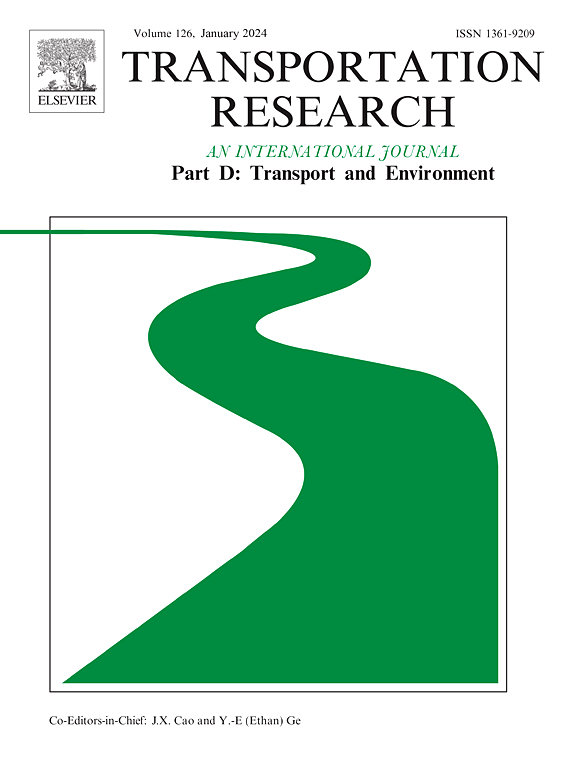考虑外部性的电动汽车小型化对共享出行的影响
IF 7.3
1区 工程技术
Q1 ENVIRONMENTAL STUDIES
Transportation Research Part D-transport and Environment
Pub Date : 2025-05-26
DOI:10.1016/j.trd.2025.104794
引用次数: 0
摘要
汽车电气化的全球趋势导致了经济实惠的紧凑型车型的兴起。本研究使用基于代理的模拟来检验车辆小型化对汽车共享系统的影响。提出了一种基于车辆大小和分乘规则匹配车辆需求的车辆调度模型。为了探讨车辆大小如何影响交通运行,我们采用宏观基本图。我们关注以双座汽车为代表的小型车型,以及以共享自动电动汽车系统为原型的有效汽车共享。利用曼哈顿网络,我们设计了场景来评估调度模型的性能、最优车队规模、乘车分流效应以及紧凑型车辆对客户体验和社会效益的影响。研究结果表明,用80%的双座汽车取代标准的五座汽车显著提高了各项指标的性能,突显了小型汽车在未来汽车共享系统中的巨大潜力。敏感性分析证实了我们研究结果的稳健性。本文章由计算机程序翻译,如有差异,请以英文原文为准。
Impact of electric vehicle downsizing on shared mobility considering externalities
The global trend of vehicle electrification has led to the rise of affordable, compact models. This study examines the impact of vehicle downsizing on car-sharing systems using agent-based simulations. We present a vehicle dispatching model that matches vehicles to demand based on size and ride-splitting rules. To explore how vehicle size affects traffic operations, we employ the macroscopic fundamental diagram. We focus on two-seat vehicles as representatives of small models and the shared automated electric vehicle system as a prototype for effective car-sharing. Utilizing the Manhattan network, we design scenarios to assess the performance of dispatching models, optimal fleet sizes, ride-splitting effects, and the influence of compact vehicles on customer experience and social benefits. Results show that substituting standard five-seat vehicles with 80% two-seat vehicles markedly improves performance across various metrics, highlighting the significant potential of small-sized vehicles in future car-sharing systems. Sensitivity analysis confirm the robustness of our findings.
求助全文
通过发布文献求助,成功后即可免费获取论文全文。
去求助
来源期刊
CiteScore
14.40
自引率
9.20%
发文量
314
审稿时长
39 days
期刊介绍:
Transportation Research Part D: Transport and Environment focuses on original research exploring the environmental impacts of transportation, policy responses to these impacts, and their implications for transportation system design, planning, and management. The journal comprehensively covers the interaction between transportation and the environment, ranging from local effects on specific geographical areas to global implications such as natural resource depletion and atmospheric pollution.
We welcome research papers across all transportation modes, including maritime, air, and land transportation, assessing their environmental impacts broadly. Papers addressing both mobile aspects and transportation infrastructure are considered. The journal prioritizes empirical findings and policy responses of regulatory, planning, technical, or fiscal nature. Articles are policy-driven, accessible, and applicable to readers from diverse disciplines, emphasizing relevance and practicality. We encourage interdisciplinary submissions and welcome contributions from economically developing and advanced countries alike, reflecting our international orientation.

 求助内容:
求助内容: 应助结果提醒方式:
应助结果提醒方式:


